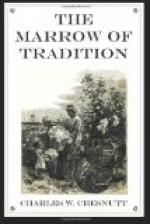Ellis had never pretended to that intimate knowledge of negro thought and character by which some of his acquaintances claimed the ability to fathom every motive of a negro’s conduct, and predict in advance what any one of the darker race would do under a given set of circumstances. He would not have believed that a white man could possess two so widely varying phases of character; but as to negroes, they were as yet a crude and undeveloped race, and it was not safe to make predictions concerning them. No one could tell at what moment the thin veneer of civilization might peel off and reveal the underlying savage.
The champion cakewalker, much to the surprise of his sable companions, who were about equally swayed by admiration and jealousy, disappeared immediately after the close of the performance. Any one watching him on his way home through the quiet streets to old Mr. Delamere’s would have seen him now and then shaking with laughter. It had been excellent fun. Nevertheless, as he neared home, a certain aspect of the affair, hitherto unconsidered, occurred to him, and it was in a rather serious frame of mind that he cautiously entered the house and sought his own room.
* * * * *
The cakewalk had results which to Sandy were very serious. The following week he was summoned before the disciplinary committee of his church and charged with unchristian conduct, in the following particulars, to wit: dancing, and participating in a sinful diversion called a cakewalk, which was calculated to bring the church into disrepute and make it the mockery of sinners.
Sandy protested his innocence vehemently, but in vain. The proof was overwhelming. He was positively identified by Sister ’Manda Patterson, the hotel cook, who had watched the whole performance from the hotel corridor for the sole, single, solitary, and only purpose, she averred, of seeing how far human wickedness could be carried by a professing Christian. The whole thing had been shocking and offensive to her, and only a stern sense of duty had sustained her in looking on, that she might be qualified to bear witness against the offender. She had recognized his face, his clothes, his voice, his walk—there could be no shadow of doubt that it was Brother Sandy. This testimony was confirmed by one of the deacons, whose son, a waiter at the hotel, had also seen Sandy at the cakewalk.
Sandy stoutly insisted that he was at home the whole evening; that he had not been near the hotel for three months; that he had never in his life taken part in a cakewalk, and that he did not know how to dance. It was replied that wickedness, like everything else, must have a beginning; that dancing was an art that could be acquired in secret, and came natural to some people. In the face of positive proof, Sandy’s protestations were of no avail; he was found guilty, and suspended from church fellowship until he should have repented and made full confession.




